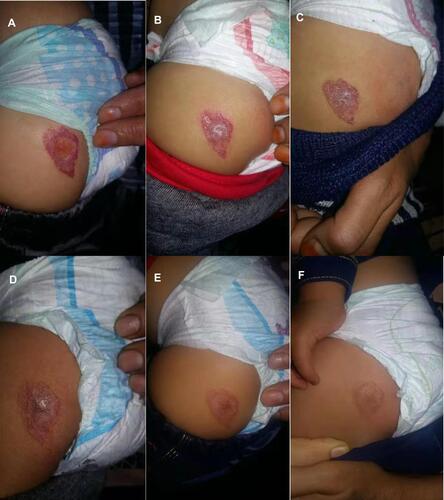Abstract
Infantile hemangiomas (IHs) are the most common vascular tumors in childhood. We report the use of propranolol to treat the growth phase of IHs. Propranolol was given to a 6-month-old infant who presented with a 4-cm sharply demarcated hemangioma on his left gluteal region. After relevant evaluation, propranolol was prescribed with a starting dose of 1 mg/kg/day, given in 3 divided doses. Vital signs were monitored during the first 6 hours of treatment. In the absence of side effects, treatment was continued at home with 2 mg/kg/day for six months, and the child was reevaluated after 7 days of treatment and then monthly. After one month, effects on color and growth were noted. Complete healing occurred in less than 6 months. Side effects and relapse were not reported. Propranolol administered orally at 2 mg/kg/day was successful, leading to near resolution of the patient’s hemangioma.
Introduction
Infantile hemangiomas (IHs) are benign vascular tumors that commonly affect children with a 5% prevalence rate.Citation1 The tumors are structured by endothelial cells, fibroblasts, mast cells and pericytes.Citation2 Most IHs are small, innocuous, and self-resolving and require no treatment. However, because of their size, location, and ulceration, a significant minority of IHs are potentially problematic.Citation3 In many parts of the world, beta-blockers have been successfully used for the treatment of IHs since 2008,Citation4 but in Afghanistan, they have not yet become standard of care. The majority of clinicians in Afghanistan still do not use propranolol for treatment. Therefore, we want to share our experience to encourage other healthcare providers in Afghanistan to adopt this standard of care practice. Herein, we report our experience on the efficacy of propranolol for the treatment of a child in Afghanistan who presented with a hemangioma in the gluteal region.
Case Presentation
A 6-month-old term male infant presented to our outpatient dermatology clinic with a 4 cm × 2.5 cm sharply demarcated erythematous plaque with a small central ulceration in his left gluteal region (). His mother reported that the lesion was barely evident at birth and was more visible several days after birth. The family did not seek medical advice before six months of age. Due to the ulceration in a sensitive location, we elected to treat with oral propranolol. Cardiac and respiratory exams, blood glucose, blood pressure, and heart rate were normal. We administered an initial dose of propranolol 1 mg/kg/day divided three times and in one hour checked blood glucose, blood pressure and heart rate which were normal. We continued this treatment for 7 days. After one week, the lesion’s size had decreased slightly with less discoloration. Propranolol dose was increased to 2 mg/kg/day divided three times, and the patient followed up every month. After 8 months, the patient’s hemangioma had nearly resolved (). We gradually tapered the propranolol over 2 months. The HI resolved with an atrophic scar. No adverse effects were reported. There was no recurrence at follow-up at 18 months of age ().
Discussion
Drug therapy is the most common treatment method for complicated infantile hemangiomas. Oral corticosteroids had long been used as first-line drugs, but since 2008, many doctors worldwide have been using propranolol to treat IHs.Citation5 At present, propranolol is the treatment of choice for complicated IHs in many countries. However, in Afghanistan, it had not been used before 2014.Citation6 Many clinicians continue to use oral corticosteroids with their related complications, and in some cases, surgery has been performed with adverse outcomes. Meanwhile, some dermatologists remain reluctant to use propranolol due to potential serious adverse effects in young patients.Citation7 Studies revealed that the efficacy rate of propranolol was greater than that of corticosteroids in treating IH. Additionally, propranolol had fewer complications than steroids.Citation5 In our dermatology department, we preferentially treat with oral propranolol now.
For the treatment of IHs, 10 mg propranolol tablets available on the market are used. We divide the tablets with a pill cutter.Citation6 In Afghanistan, we face challenges in obtaining consent for long-term therapy, and consistent follow-up is difficult.
In this case, in addition to thorough education for the parents before initiation of treatment, they were encouraged by the rapid improvement of the IH with propranolol. Therefore, they continued the prescribed treatment and participated in regular follow-up until the IH resolved, and treatment protocol was completed.
Conclusion
Treatment of IH with oral propranolol is the first-line therapy worldwide, but still in Afghanistan, HIs are often treated with corticosteroids which are not as effective and may be associated with numerous adverse effects. This case presentation may encourage dermatologists in Afghanistan to follow standard guidelines for management of this disease.
Abbreviation
IH, Infantile hemangioma.
Ethical Approval and Consent to Participate
The authors certify that they have obtained all appropriate patient consent forms. Written informed consent was obtained from the patient’s father for the publication of this case report and accompanying images. The study was approved by the Kabul University of Medical Sciences Ethics Committee.
Disclosure
The authors report no conflicts of interest in this work.
References
- Chen TS, Eichenfield LF, Friedlander SF. Infantile hemangiomas: an update on pathogenesis and therapy. Pediatrics. 2013;131(1):99–108. doi:10.1542/peds.2012-1128
- Schwartz R, Sidor M, Musumeci M, Lin R, Micali G. Infantile haemangiomas: a challenge in paediatric dermatology. J Eur Acad Dermatol Venereol. 2010;24:631–638. doi:10.1111/j.1468-3083.2010.03650.x
- Krowchuk DP, Frieden IJ, Mancini AJ, et al. Clinical practice guideline for the management of infantile hemangiomas. Pediatrics. 2019;143(1):e20183475. doi:10.1542/peds.2018-3475
- Léauté-Labrèze C, de la Roque ED, Hubiche T, et al. Propranolol for severe hemangiomas of infancy. N Engl J Med. 2008;358(24):2649–2651. doi:10.1056/NEJMc0708819
- You Y, Li Y, Xiao Y, Zhang J. Propranolol vs. steroids in the treatment of infantile hemangiomas: a meta-analysis. Mol Clin Oncol. 2021;15(2):1–9. doi:10.3892/mco.2021.2318
- McMichael J, Lawley LP. Propranolol for infantile hemangiomas in developing countries. Dermatol Online J. 2017;23(3). doi:10.5070/D3233034282
- Bakalli I, Kola E, Lluka R, et al. Deep coma in a child treated with propranolol for infantile hemangioma. BMC Pediatr. 2019;19(1):216. doi:10.1186/s12887-019-1598-0

